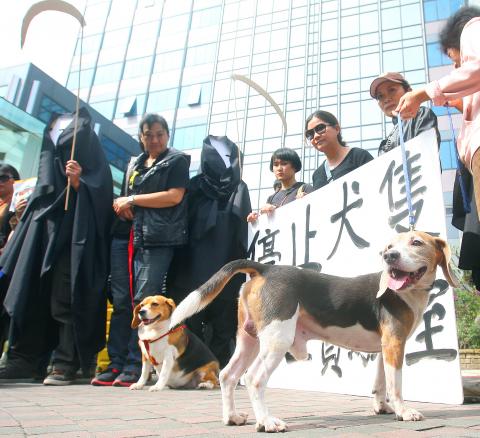Animal rights activists and pet lovers yesterday gathered in front of the Atomic Energy Council (AEC) to protest against the use of beagles in animal experiments.
The group was protesting against toxicity and safety tests for a new drug being developed by the council’s Institute of Nuclear Energy Research (INER) that are being carried out on beagles.
Holding up a banner reading “Protest against animal abuse! The AEC disregards life!” and accompanied by 10 beagles, the group of about 30 protesters urged the council to stop testing new drugs on animals.

Photo: CNA
Animal rights advocate Huang Tai-shan (黃泰山) said the council made a worldwide call for bids on the Internet earlier this month for 40 beagles to conduct drug tests.
The council is asking for beagles who have cancer, Huang said, adding that the council dissects some of the dogs on the second day after being injected with an experimental drug and that more are dissected on the 15th day of the testing.
“The lucky ones that survive the experiment are sent to other research centers for other experiments until they die,” he said.
The council denied asking for cancerous dogs, saying that the beagles imported are healthy dogs.
Wang Hsiao-hua (王小華), a member of the Kaohsiung Concern Stray Animal Association, said the beagles that were experimented on were just like any other pet beagle, and experienced fear and pain during the tests.
Many animal experiments to develop drugs have already proven ineffective, so the council should find alternative methods to test drugs, Huang said, adding that they were also strongly against the establishment of a dog radiotoxicological experiment lab at the council, as it would encourage more experiments on dogs.
The protest group submitted a petition to INER deputy director-general Shen Lie-hang (沈立漢), asking the council asking to stop the experiments on beagles.
Shen offered the group a report on the experiments they conducted inside the building.
“We don’t want to hear about the inhumane experiments, we want a clear answer from a higher authority. Life is nonnegotiable!” the protesters shouted, refusing to go inside the building for talks.
Following this, Atomic Energy Council Deputy Minister Chou Yuan-ching (周源卿) met with the protesters and agreed that the council would use official documents to inform the association of the council’s decision on the tests within two weeks.
Shen said the experiments were used to test the safety of a new drug being developed by the institute for treating colon and rectal cancer and that procedures had been carried out according to legal regulations.
Shen said that according to the Department of Health’s Guideline for the Nonclinical Pharmacology/Toxicology Studies for Medicinal Products, testing on rodents and non-rodents is necessary to ensure the safety of medicines on the human body and that the experiments should be monitored by the Institutional Animal Care and Use Committee.
Shen said the use of beagles as non-rodent experimental animals is common in many countries because of their stable gene structure
The council limited the number of dogs used to the fewest possible, Shen added.
According to Council of Agriculture statistics, about 1.52 million animals (including 291 dogs) were used in research experiments in 2009 and about 1.3 million (including 247 dogs) were used last year.

Trips for more than 100,000 international and domestic air travelers could be disrupted as China launches a military exercise around Taiwan today, Taiwan’s Civil Aviation Administration (CAA) said yesterday. The exercise could affect nearly 900 flights scheduled to enter the Taipei Flight Information Region (FIR) during the exercise window, it added. A notice issued by the Chinese Civil Aviation Administration showed there would be seven temporary zones around the Taiwan Strait which would be used for live-fire exercises, lasting from 8am to 6pm today. All aircraft are prohibited from entering during exercise, it says. Taipei FIR has 14 international air routes and

Taiwan lacks effective and cost-efficient armaments to intercept rockets, making the planned “T-Dome” interception system necessary, two experts said on Tuesday. The concerns were raised after China’s military fired two waves of rockets during live-fire drills around Taiwan on Tuesday, part of two-day exercises code-named “Justice Mission 2025.” The first wave involved 17 rockets launched at 9am from Pingtan in China’s Fujian Province, according to Lieutenant General Hsieh Jih-sheng (謝日升) of the Office of the Deputy Chief of the General Staff for Intelligence at the Ministry of National Defense. Those rockets landed 70 nautical miles (129.6km) northeast of Keelung without flying over Taiwan,

City buses in Taipei and New Taipei City, as well as the Taipei MRT, would on Saturday begin accepting QR code payments from five electronic payment providers, the Taipei Department of Transportation said yesterday. The new option would allow passengers to use the “transportation QR code” feature from EasyWallet, iPass Money, iCash Pay, Jkopay or PXPay Plus. Passengers should open their preferred electronic payment app, select the “transportation code” — not the regular payment code — unlock it, and scan the code at ticket readers or gates, General Planning Division Director-General Liu Kuo-chu (劉國著) said. People should move through the

The Ministry of National Defense (MND) today released images of the military tracking China’s People's Liberation Army (PLA) movements during the latest round of Chinese drills around Taiwan. The PLA began "Justice Mission 2025" drills today, carrying out live-fire drills, simulated strikes on land and maritime targets, and exercises to blockade the nation's main ports. The exercises are to continue tomorrow, with the PLA announcing sea and air space restrictions for five zones around Taiwan for 10 hours starting from 8:30am. The ministry today released images showing a Chinese J-16 fighter jet tracked by a F-16V Block 20 jet and the